I have been working in SEO for nearly a decade now. I’ve seen the rise and evolution of numerous strategies in that time. One such method that has continually stood out is using schema markup within websites.
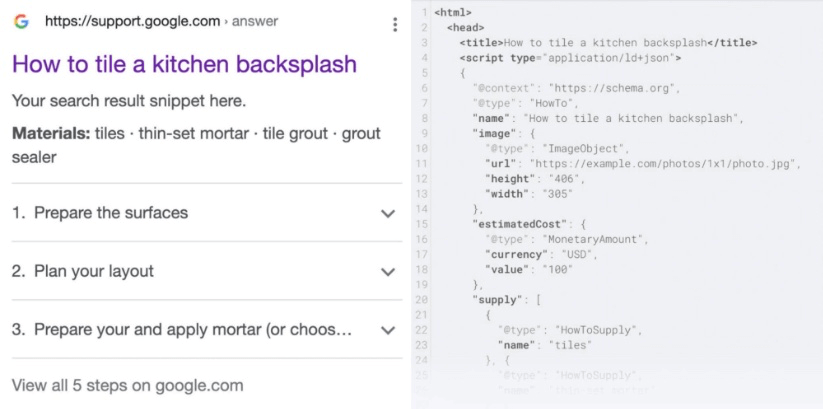
Image Credit: https://www.semrush.com/
Schema markup isn’t just another bit of “SEO jargon”, but it’s a potent tool that directly communicates more of your content to search engines, ensuring that your audience receives the most accurate information!
In this article, I will tell you what is the most comprehensive guide on the web about Schema markup. I’ll go through schema markup, why it’s important for SEO, the origins of schema, and how it works. I’ll also go through, in detail, the types of schema markup you can use on your website, its benefits, and, of course, how to implement it.
Let’s dive right into it.
What is Schema Markup?
Schema markup, often called schema, is structured data that tells search engines exactly what your content means.
Instead of leaving search engines to crawl your site and interpret the content independently, schema markup provides exact clues about your content’s type and nature.
This can range from details about a product’s price and availability to the author of a particular blog post or article to the date and location of an upcoming event.
Why is Schema Markup Important for SEO?
Search engines like Google, Bing, and Yahoo aim to provide users with the most relevant and comprehensive results for their queries. By integrating schema markup into your website, you offer these search engines more precise insights into your content, which can lead to richer, more informative search results known as ‘rich snippets’. These enhanced results can boost your site’s click-through rate (CTR), improve user experience, and influence search rankings.
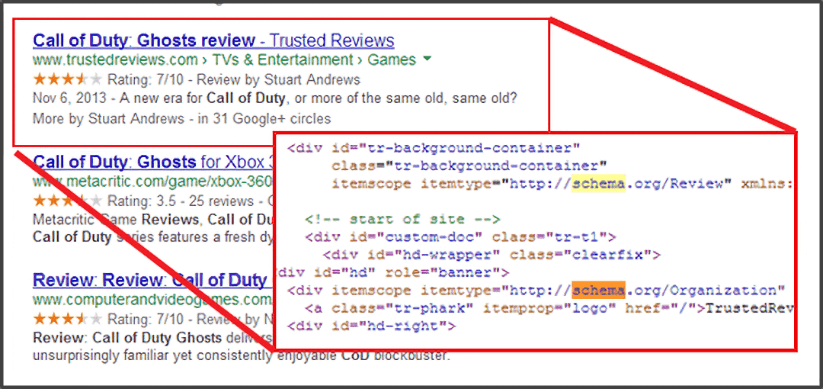
Image Credit: https://www.wordstream.com/
Moreover, as voice searches become increasingly popular through devices like smartphones and smart speakers, schema markup is instrumental in making your content ‘voice search friendly’.
Dive into this comprehensive guide to understand the nuances of schema markup, its implementation, and its pivotal role in SEO.
Search engines like Google, Bing and Yahoo (if anyone still uses Yahoo anymore) aim to provide users with the most relevant and comprehensive results for different search queries that users perform.
By integrating schema markup into your website, you offer these search engines a much clearer insight into your content, which can lead to richer, more informative search results, simply known as ‘rich snippets’. These enhanced results can boost your site’s click-through rate, improve user experience and even (potentially) impact search rankings.
We also need to talk about voice search.
As voice searches become increasingly widespread through devices like smart speakers and digital assistants, the need for precise data interpretation by search engines is critical. Schema markup can play an essential role in this aspect.
When users ask their devices questions, the structured data provided by schema helps search engines find and locate this data quickly and deliver accurate answers.
Everyone talks about different statistics for voice search, but it’s so important. DemandSage tells us that over 1 Billion voice searches are performed monthly, so optimising your content for voice search using schema isn’t just a piece of advice anymore; it’s essential for staying ahead in the digital space.
The Basics of Schema Markup
As the digital world becomes more complex, search engines are constantly seeking better ways to understand content on the web. Schema markup has emerged as the solution to this challenge as it bridges website content and search engines’ understanding of this content.
In this section, I’ll go through the origins of schema markup and how it works.
The Origins: Schema.org and Search Engines
In 2011, four major search engines (Google, Bing, Yahoo, and Yandex) created Schema.org. This effort was to create a unified and centralised vocabulary for the structured data markup on web pages. Today, Schema.org is the absolute industry standard for implementing schema markup on websites, boasting a massive collection of item types and properties suitable for almost any purpose.
Essentially, these four search engines knew it was vital to create a standardised way to allow their search engines to understand content on websites better for them to display rich snippets for some of the websites listed in the SERPs. So they came together and did it. Schema.org was the byproduct of that process occurring.
How It Works: JSON-LD, Microdata, and RDFa
Three main formats allow you to integrate schema markup on a website: JSON-LD, Microdata and RFDa.
JSON-LD stands for JavaScript Object Notation for Linked Data, and it is the most popular and recommended format by experts worldwide. It uses a linked data format to embed a block of JavaScript on the page, allowing for a more modular and easily manageable approach to implementing schema markup on a site.

Image Credit: https://hallanalysis.com/
Microdata requires adding specific attributes to existing HTML tags. It is undoubtedly more integrated with the content when compared to JSON-LD and RDFa; it may make your HTML slightly more cluttered. This isn’t necessarily bad, but it’s also a riskier approach when compared, especially to JSON-LD.
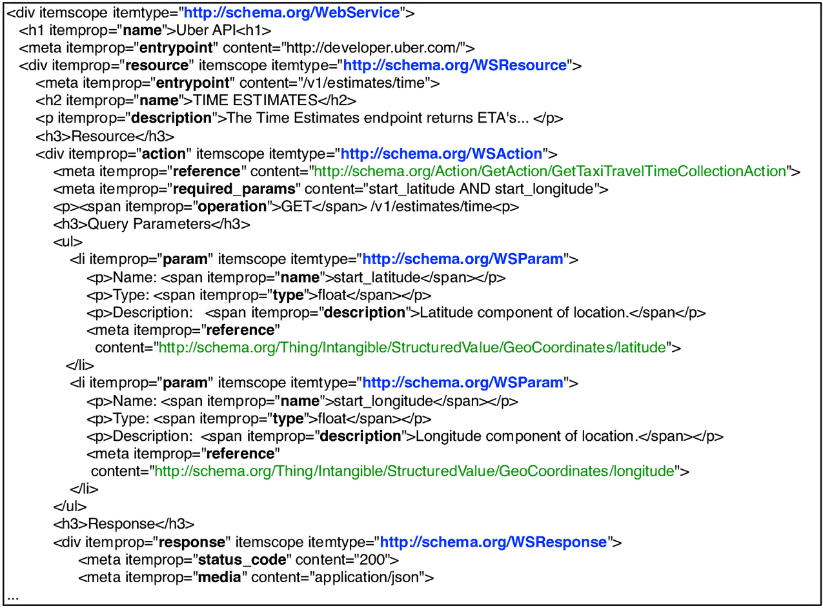
Image Credit: https://www.researchgate.net/
RDFa standard for Resource Description Framework in Attributes. It’s another method of adding structured data directly to HTML or XHTML elements.
Of the three, Google generally recommends implementing schema using the JSON-LD method. This is because it’s easy to implement and completely separate from the content, meaning it’s less prone to disruptions when updating web pages.
The Different Types of Schema Markup
This is not an exhaustive list of all the different schema types, but we will take you through some of the most commonly used types so you can apply this information to your website immediately.
Organisation
Organisation schema is a specific type of structured data markup that allows webmasters and marketers to provide search engines with detailed information about an organisation. This can include the name of the business, a business logo, contact details, location, and any other relevant attributes.
By integrating the organisation schema into your website, you, as an SEO, can enhance how your business details are displayed in search results. This can have several positive effects, improving click-through rates and brand recognition.
Incorporating this schema on your website will help search engines understand and display your business information more effectively. This can be especially valuable for brand searches and contribute to rich results like knowledge panels.
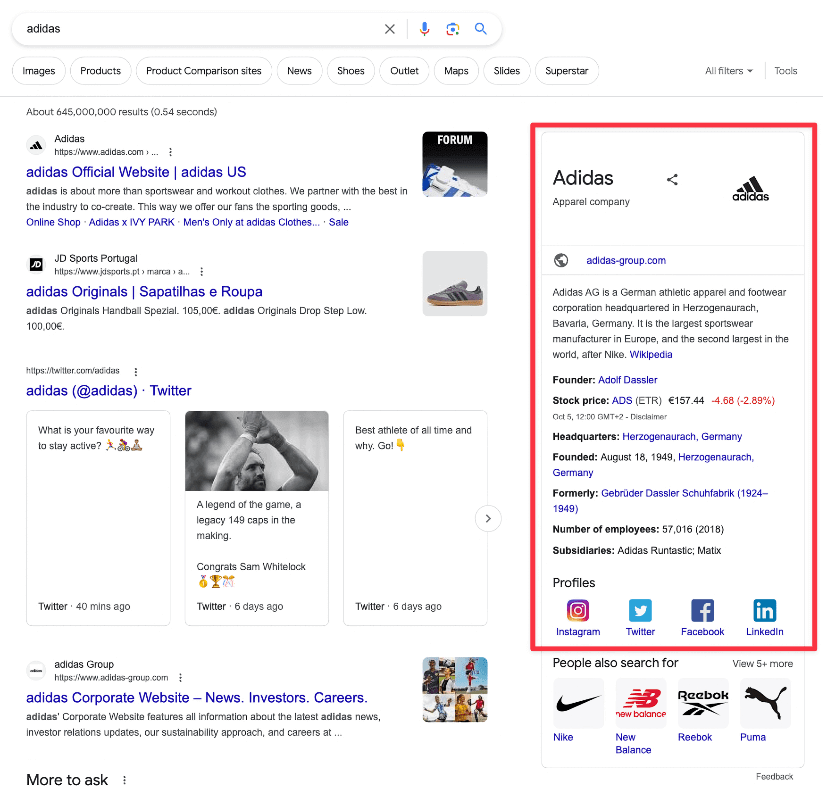
Person
Person schema will enable you to provide search engines with detailed information about a specific individual. This can include a person’s name, job title, relevant affiliations, a headshot, and contact details.
By embedding person schema into your website, you can enhance how personal details are presented in search results, potentially improving click-through rates. Any website with a blog should be using this type of schema on their site.
There is another way this helps, too. It will help when trying to demonstrate E-E-A-T on your website. Adding person schema will allow search engines to understand better who has written or edited the content, meaning they will better see how experience, expertise, authority and trust can be shown.

Image Credit: https://wpschema.com/
Product
Product schema was designed to provide search engines with detailed information about products. By implementing this markup, marketers can specify different attributes directly on a product page, such as:
- Product name.
- Brand.
- Model.
- Price.
- Availability.
- Ratings.
As well as many other valuable attributes. The main goal of this schema is to allow products to be displayed in a “richer” way! This will, in theory, lead to more informative and eye-catching listings, providing immediate insights into your product’s features and benefits.
For SEOs, leveraging the product schema can offer several advantages over sites not using it! Firstly, it can significantly enhance a product’s visibility in search results by allowing for rich snippets. These effectively enhance search results that display the key attributes (that we went through above) directly within the search listing. This richer display can improve CTR, as users can quickly gauge how relevant a product is and how much it appeals to them.
Additionally, the structured nature of product schema ensures search engines clearly understand the product being presented. This could improve its relevance for essential search queries. Moreover, with the rise of voice search and smart assistants, structured product data can be critical for being featured in voice search results or recommended by virtual shopping assistants.

Image Credit: https://www.groovecommerce.com/
Event
Do you run events as an organisation? You need to understand the event schema type and how it can help you.
Event schema was created to give search engines comprehensive details about your business’s events. Using this markup type, you can provide attributes for your events, including their name, location, start and end times/dates, ticketing information, and organising details.
This markup is designed to allow search engines to show rich snippets for your events along with other search results, offering users a snapshot of your event’s essential details directly on your SERP listing.
Implementing any event schema can significantly increase your online visibility and engagement for any event-related content you publish. This enhanced representation in the SERPs can substantially improve click-through rates as users can see an overview of the event without needing to click through. Users who know more about your event from the outset are likelier to click!

Image Credit: https://rankmath.com/
The Full-Scale of Schema
According to Umbraco, there are currently 792 types of schema markup, meaning there is a markup for almost every use you can think of! Of course, you don’t need to understand them all, but you will need to learn your business’s crucial markup types to utilise.
Benefits of Using Schema Markup
Now that we have discussed schema markup, why it’s vital for SEO, and some of the critical types of schema markup, we can move on to some benefits that regularly using schema markup on your website will offer.
Enhanced Search Results (Rich Snippets, Knowledge Graphs, etc.)
In case you didn’t already know, rich snippets are the enhanced search results you see on a SERP. They differ from standard listings because they display additional, important information. For example, a rich snippet for a recipe might include star ratings, prep time, or even a thumbnail image of a completed dish.
The mechanics behind this enhanced display are made to work by schema markup. When search engines crawl a webpage embedded with schema markup, they can easily extract the marked content and use it to generate these rich snippets.
Without schema, search engines would have to infer this information, which could lead to less accurate or less rich snippets overall. Schema markup offers a direct way for webmasters to feed search engines the precise data they want to display in rich snippets. This enhances both the user’s search experience and the webpage’s visibility.

Image Credit: https://ahrefs.com/
Increased Click-Through Rate
Schema markup, as we know, enhances the visibility and informational depth of a web page’s listing in the SERPs through the display of rich snippets. These rich snippets, which can include elements such as star ratings, images, and product prices, as discussed earlier, offer users a more detailed look into the web page’s content compared to standard listings without snippets.
As a result, users can make more informed click decisions, leading to a higher chance of engaging with search results that most align with their intent. Websites with rich snippets will often stand out visually and informationally, making them infinitely more clickable.
Whilst specific data values vary, various studies have shown that rich snippets can boost click-through rates. Milestone Research analysed over 4.5 million queries to find users click on rich results 58% of the time, compared to a CTR of 41% for non-rich results.
Improved Local SEO
Using schema markup, especially the “LocalBusiness” type, will allow businesses to provide specific details about their local premises to search engines. This information will include the business type, operation hours, address, contact details, and customer reviews.
When search engines clearly understand these details, they can offer users more accurate and informative local search results. This increased information that search engines hold will boost visibility in local searches and lead to increased trust and engagement from potential customers.
For example, suppose I search for “shoe shop in Nottingham, UK”. In that case, I am likelier to click on a business that has used the LocalBusiness schema as I will have more information immediately than a business that does not.
Better Voice Search Optimisation
If you have it as part of your strategy to optimise for voice, schema markup is crucial. Voice assistants like Google Assistant, Siri, and Alexa rely massively on structured data to provide quick and accurate answers.
When users make voice searches, they usually want direct and short answers. Schema markup facilitates this by offering clear information about a webpage’s content. By using schema, marketers can label their content, making it easier for voice search algorithms to identify and select the most relevant information to read back to the user.
For example, if I want a recipe, schema markup on a webpage will allow a voice assistant to provide step-by-step cooking instructions or list the ingredients, depending on what I ask precisely.
As voice assistants grow in popularity, having content correctly optimised by schema increases the likelihood of it being chosen as the preferred answer for voice queries.
How to Implement Schema Markup
Now we know all about schema, it’s time to get down to the actual “meat” of the article, where you will learn how to implement it on your website. We’ll discuss the tools & plugins you can use to implement it, we will talk about manual implementation, and we will also go through testing & validating your schema with Google’s structured data testing tool!
Tools & Plugins for Different Platforms
Several different tools and plugins are available to assist webmasters and marketers with the implementation of schema markup on their websites.
For those using WordPress, plugins like All In One Schema.org and Rich Snippets and Schema Pro offer user-friendly graphics to integrate structured data without in-depth coding knowledge. These plugins give you easy-to-complete forms for different schema types, automatically generating and embedding the necessary markup on chosen pages. Another excellent option for WordPress users is Yoast SEO, which also aids in adding schema markup to a website and its terrific SEO monitoring abilities.
Outside of WordPress, tools like Google’s Structured Data Markup Helper allow you to select elements on your webpage and generate the appropriate schema markup. Once implemented, the markup can be added directly to the webpage’s code. Along similar lines, Schema Markup Generator by Merkle offers a simple interface to create specific types of Schema.
After implementing schema, it’s always good practice to validate it. We will talk about this a little later.
Manual Implementation
As discussed earlier, You can manually implement schema markup using formats like JSON-LD, Microdata, or RDFa. Marketers, developers or webmasters can choose the appropriate schema type from Schema. Org and then create the markup with the required properties and attributes. This is then embedded in the page’s source code.
Any manual implementation will offer a high degree of precision and customisation. You can ensure that the markup perfectly aligns with your content, catering to specific nuances or requirements that automated tools might not address correctly. There’s also no dependence on third-party plugins or devices, which can sometimes bloat a website or become outdated, leading to issues with compatibility.
This manual approach requires a good understanding of the chosen markup language and the specific schema specifications, making it challenging for those who need to be well-versed in coding or structured data. Any mistakes or missing information in the markup can lead to ineffective schema implementation or errors. Manual undertaking can also be time-consuming, especially for large websites with many pages requiring different schema types. There is also a risk of missing out on new schema updates if you aren’t actively keeping up with developments.
Testing & Validating your Schema Markup
Once you have created your schema markup, whether you have done it manually or through an external tool or plugin, you must test & validate it to make sure it will work on your site.
Google has a great tool to do this, the Rich Results Test, where you can enter a URL for a live page or the code directly. Google will then crawl this and ensure the schema is working as intended.
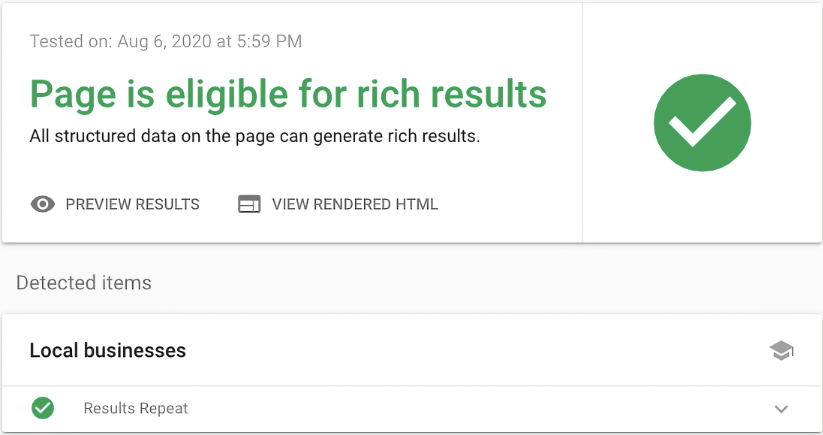
Image Credit: https://resultsrepeat.com/
You can also use the Validator tool directly from Schema.org. It works the same way as Google’s tool, allowing you to input a URL or a code snippet and then run through it and validate it, listing any errors that have occurred so you can fix these before implementing it on your site.
Advanced Schema Markup Techniques
Once you learn more and get comfortable with using schema markup on your website, there are a few advanced techniques you should look into to make your website better from a structured data perspective.
Using Nested Schemas
Nested schema is the practice of embedding one schema markup type within another. This will help provide more detailed and interconnected information about a specific item. It gives search engines an even deeper understanding of the relationships and attributes of on-page content.
For example, if a webpage contains schema markup for an article, the author will probably be mentioned within that. A nested schema can detail the author’s information, like their name, image, and bio. This layered approach ensures that each piece of content you publish is accurately represented and linked, offering a comprehensive view of the web page’s content hierarchy and its various entities.
Combining Multiple Schemas
Combining multiple schemas involves integrating different types of schema markup on a single page to represent diverse content elements.
For example, a webpage might feature a product currently available for purchase (meaning product schema is required), and the page will also have customer reviews (requiring review schema).
By combining these schemas, you can provide search engines with a detailed understanding of both the product and the reviews simultaneously. Properly merging multiple schemas will ensure that search engines grasp the full context of a webpage’s content, meaning there’s a better chance for rich snippets in search results.
This blog post has given you all the information you need about schema markup and how it can be used for marketing purposes on your website. We’ve gone into detail about what schema is, why it’s crucial for SEO, some of the different schema types and how to create it on your site. Plus, we’ve also given you a couple of advanced schema markup techniques you can go away and use today.
SEO testing is complex, right? Make the process easy with SEOTesting. We use the Google Search Console API to make it easy for you to see what changes have resulted in positive SEO gains at the click of a button. You can also use it to see how implementing schema impacts your site! We currently have a 14-day free trial, so if you want to see what SEOTesting can do for your business, sign up today.

